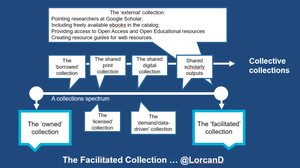I have just acquired Virtual learning environments: using choosing and developing your VLE by Martin Weller. VLE is a term popular in the UK for Course or Learning Management System. Weller is Professor of Educational Technology at the Open University where he directed their VLE project. The Open University is a major user of the open source Moodle system.
Chapter 6 is about the Managed Learning Environment (MLE), a term used for the ensemble of systems and services which support learning in an institution. Weller identifies portal, library, student record system and content management system as important other components in the MLE. His discussion about libraries and the interaction with the VLE is concentrated in this chapter.
The relationship between VLEs and library systems reflects the changes in practice and internal politics wrought by the advent of e-learning perhaps more than any of the other systems. There is a sense in which the very identity of libraries and their function in the educational process is at stake. Just as e-learning has induced much navel gazing and concern amongst educators regarding their role, and the potential commoditization of education, so it is with librarians. The answer, however, is largely the same – e-learning makes the store of information less significant, but in such an information-rich world it makes the skills of dealing with information more valuable. [p. 67]
He then suggests a continuum of potential for the library, from redundant to central. “At one extreme the need for a library becomes superfluous – at its simplest this might be categorized as ‘I’ve got Google, what do I need a library for?'” [p. 67] In this redundant model, necessary materials are loaded into the VLE, and it points to other resources out on the open web.
In the central approach, the library mediates access to content within the VLE, providing value in selection, purposing to particular tasks, metasearch and so on.
The VLE and library interface then is one fraught not only with problematic technical issues, but also with a political dimension. There have been no shortage of projects examining the interface between the two, indeed there is something of a project overload, without a real consensus reached as to the ideal configuration. The main areas where the two systems interface is with the location of resources, and more specifically the following:
- locating and importing resources into a VLE;
- storing data about new types of resources, for example learning objects, within library catalogues;
- managing rights and clearance for resources;
- indexing and describing resources. [p. 68]
He mentions that the VLE may be managed within different organizational contexts, including some in which it is located within the library. The relationship between the library and the learning management system has indeed been a topic of much discussion in recent years. And we are seeing a growing discussion about the role of the library in relation to e-science and data curation. As more activities move onto the network, workflow and information management become pervasive issues which prompt interesting questions about how academic support services are best configured.



